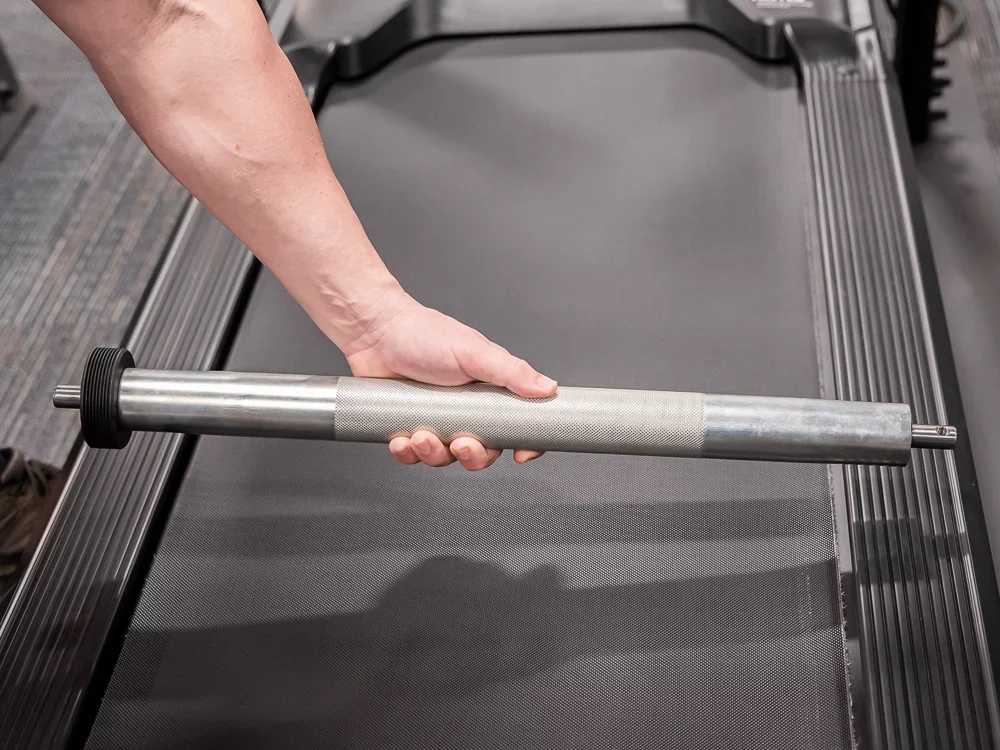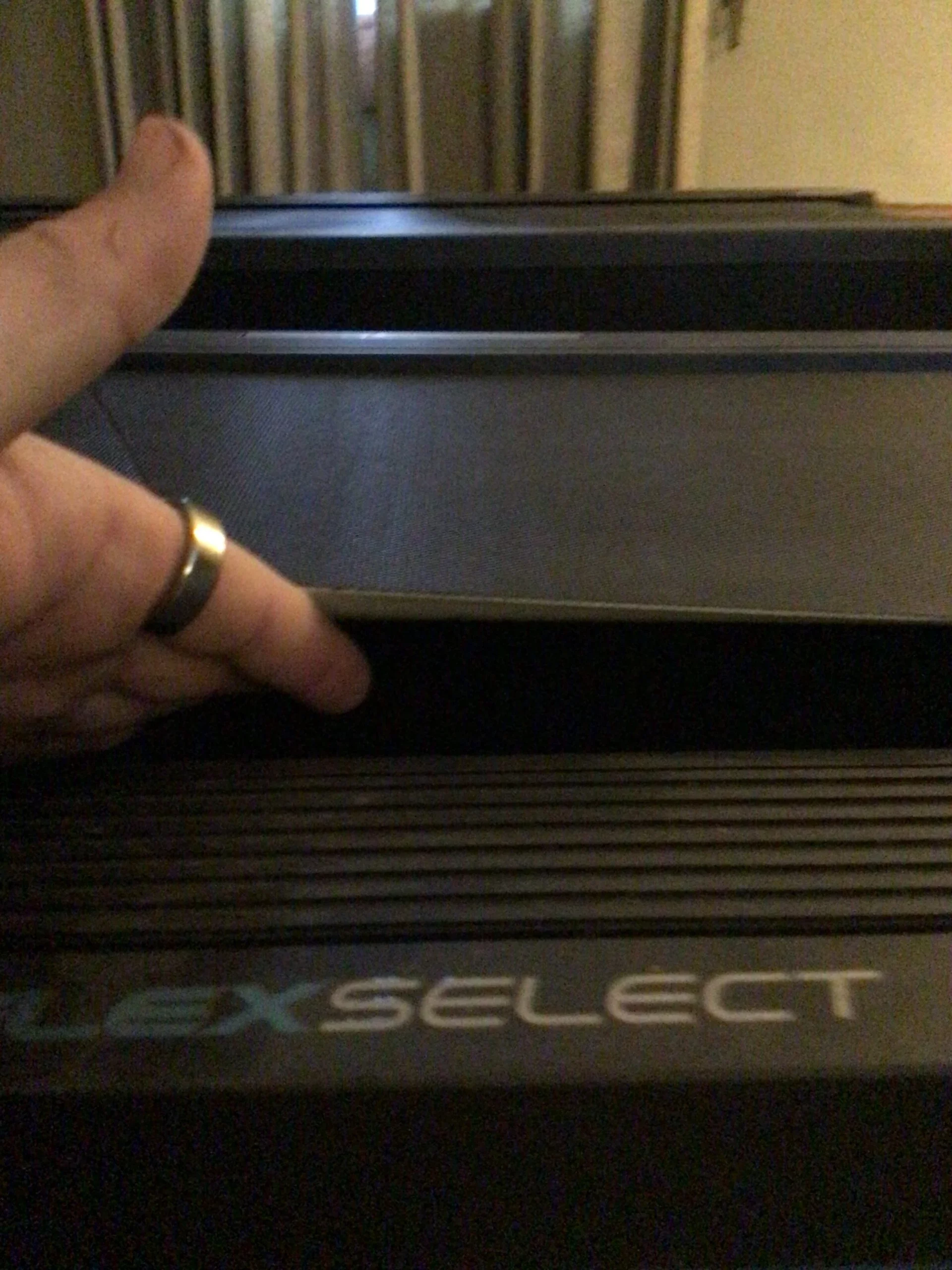Treadmill Belt Tension and Alignment
Remember, it’s a treadmill, not a slip ‘n slide. The deck and belt of a treadmill are two of the primary components, next to the motor, and they do require alignment from time to time. Whether you’ve over- or -under-lubricated a belt, or you had to replace one, adjusting the tension and aligning a treadmill belt are just a couple of have-to’s you’ll meet along the path of ownership.
The term belt tension refers to how snug the belt runs along the deck. As a rule, you should be able to gently lift the belt with your fingertips about three inches, but not more than four. The term belt alignment refers to whether it’s centered, or shifting more to one side than the other.
Belt tension and alignment are part of a larger scope of maintenance which includes fixing belts which skip, centering the belt, and replacement. But fear not, this isn’t astrophysics. Whether a top-tier machine or a budget-friendly piece purchased used, treadmills are built to be adjusted just like any other piece of exercise equipment.
Maintenance Matters
Don’t feel lonely. People buy treadmills everyday without considering maintenance. The good news is, it’s not difficult and there are scads of online resources as well as user manuals. But maintenance is just as necessary for treadmills as cars and going without has the same result.
Consider that the deck is the actual hard running surface atop which the belt glides, pulled by rollers which are driven by a motor. Most decks these days are made of Medium Density Fiberboard (MDF) and coated with the same phenolic resin used on billiard balls. Remember, treadmill belts can:
- Stretch out and loosen over time.
- Become brittle for lack of lubrication.
- Get wobbly from frayed ends which connect the rollers.

The tread belt is pulled across the deck by rollers and a motor. Check to make sure the belt is aligned properly if slipping occurs. Photo by: Oleksandr Kosheliev / TreadmilReviews.net
How to Spot a Problem With Your Treadmill Belt?
The first sign of an alignment issue would be the belt drifting to one side. If left unchecked, this will only get worse as it’ll begin to roll unevenly and tear apart. Belts might also start to stall a bit at this point. Hopefully it’s just a simple alignment or tension issue and you don’t need a new belt….yet.
A couple quick tests can tell you whether you have a tension issue or belt out of alignment. If a 250-pound runner feels the belt slipping, but a 150-pound runner does not, this would be an issue of tension. Granted, those weight differences seem a bit extreme, but you can reason the point. And if it’s a family treadmill, or perhaps you have roommates, then the chances of users varying that much in weight are pretty high. A heavier user places more stress on the belt and deck than a lighter runner, which is why some treadmills are specifically designed for larger people.
Another quick test is to lift the belt up front the deck with your fingertips. If you can easily lift the belt more than four inches, it’s too loose and you have a tension issue. If it won’t easily go up three inches, then it’s too tight. The belt should be snug, but not too tight. Overtightening a belt can cause more friction and stretch it out.
Another indicator of belt tension as opposed to alignment is a skipping belt. This either means the tread belt is loose or the drive belt, which connects the motor to the front roller and propels the tread.
But if those tests all check out good, then it’s probably just an alignment issue and that’s easy enough to fix.

Treadmill belts should be tight enough that only about 3″ of tread can be lifted up.
What’s The Worst That Can Happen?
What kind of people keep using a loose treadmill belt? The same kind of people who driven a car with a “Check Oil” light on or try to just a few more miles with the “Low Fuel” signal flashing. And if we’re honest, that’s all of us at one time or another. But adjusting the treadmill belt is simpler than changing oil. If left unchecked though, you’re definitely going to have to buy a new treadmill belt at some point. Most belts on your higher-end home treadmills come as 2-ply, which means there’s an undercoating of fabric between the running side and the deck. Cheaper treadmills bring a 1-ply belt without that undercoating. When it comes to using an off-center or loose belt though, it’s just a matter of time before it needs replaced. If left go too long, it could also damage the rollers and potentially the motor.
In the end, like lubrication, belt alignment can go a long way to maximizing the life of your treadmill. And whether you’ve spent $800 or $8,000, there’s just no point in letting that go out the window.
Other Treadmill Reviews:
- Test HomePage
- NordicTrack Commercial X14i
- Echelon Stride
- NordicTrack C 590 Pro
- NordicTrack T 7.5 S - Pros & Cons (2024)
- Sole TD80 Treadmill Desk
- NordicTrack Commercial X11i
- NordicTrack T 8.5 S - Pros & Cons (2024)
- Horizon Elite T5
- Exerpeutic TF1000
- NordicTrack T 6.5 S - Pros & Cons (2024)
- ProForm Sport 5.0
- ProForm Premier 900
- ProForm ZT6
- NordicTrack FreeStride Trainer FS5i (Discontinued)
- Bowflex Max Trainer M5
- BowFlex TreadClimber TC100
- ProForm Power 795
- ProForm Sport 7.0
- NordicTrack Incline Trainer X15i
- NordicTrack C 1650 Treadmill
- Horizon Elite T9
- Official Boston Marathon Treadmill 4.0
- NordicTrack Treadmill Desk
- NordicTrack C 1630 Pro
- NordicTrack C 970 PRO
- Bowflex TC20 TreadClimber

